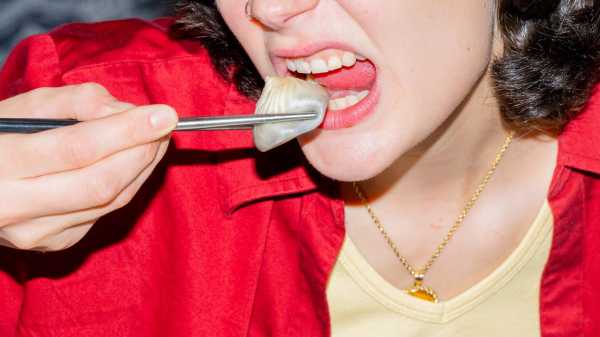
Save this storySave this storySave this storySave this storyYou’re reading the Food Scene newsletter, Helen Rosner’s guide to what, where, and how to eat. Sign up to receive it in your in-box.
Any conversation about Din Tai Fung, the Taiwanese restaurant that opened this summer in a sunken plaza near Times Square, quickly descends into a numerical rat-a-tat. The gargantuan restaurant is more than twenty-five thousand square feet in size. This new outpost is one of some hundred-and-sixty-five Din Tai Fungs, the overwhelming majority of which are in East and Southeast Asia; one, in Hong Kong, has earned a Michelin star. There are eight Din Tai Fungs in California and several others out West; the New York location, announced two years ago, is the first on the East Coast, and the largest in the world. It is open for lunch and dinner seven days a week; the dining room can accommodate four hundred and fifty souls. The kitchen can produce more than ten thousand dumplings a day; the xiao long bao, or soup dumplings, are assembled by hand and must weigh precisely twenty-one grams, with each wrapper bearing no fewer than eighteen folds.
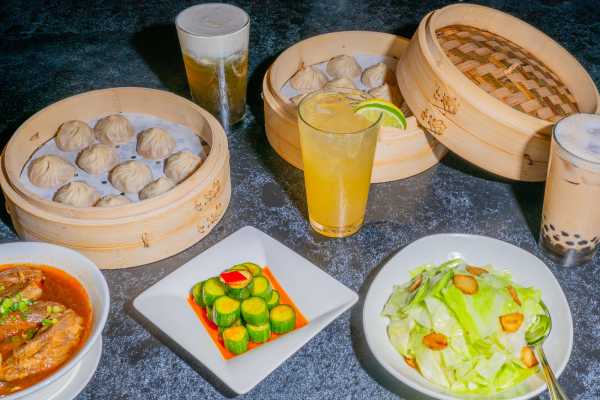
Other specialties include a chilled cucumber salad and Taiwanese-style cabbage sautéed with an incredible amount of garlic.
The scale and the spectacle of it all is remarkable in person, from the restaurant’s dramatic descent-into-the-earth staircase to the human-size bronze sculpture of an anthropomorphic soup dumpling (his name is Bao Bao; he’s Din Tai Fung’s mascot) and the dining room so enormous that its vastness can appear to be a cognitive glitch, some kind of mirror trick or optical illusion. The brand had more modest beginnings, with the founding of a family-run cooking-oil business in Taipei, in 1958. In the nineteen-seventies, the owner, Yang Bing-yi, pivoted to selling dumplings and noodles, and his single shop eventually grew into an empire. The world of Din Tai Fung is now overseen by Aaron and Albert Yang, Bing-yi’s grandsons, who marked the New York opening with a ribbon-cutting ceremony before a rapturous crowd. The restaurant’s specialty is the xiao long bao, whose delicate, whorled wrappers hold rich morsels of meat and an explosive splash of hot, savory broth. But there are plenty of excellent soup dumplings in this city, and the wait for a table isn’t nearly as long down at Joe’s Shanghai, in Chinatown, or Pinch Chinese, in SoHo (whose kitchen is run by a former Din Tai Fung executive chef). The real excitement was for the brand itself: as is the case with so many chain restaurants, Din Tai Fung is in the business of not only selling dinner but also selling nostalgia, selling familiarity, selling Din Tai Fung.
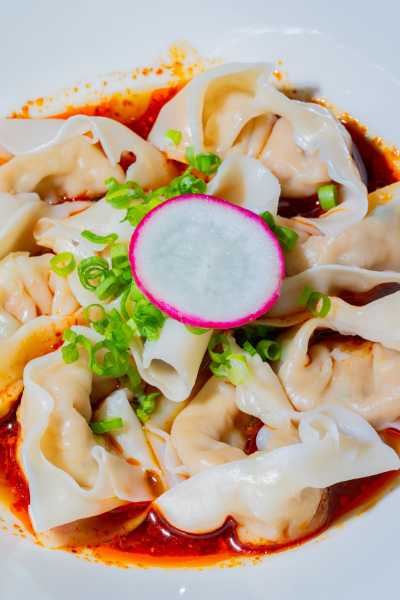
Wontons in the restaurant’s “signature house spicy sauce.”
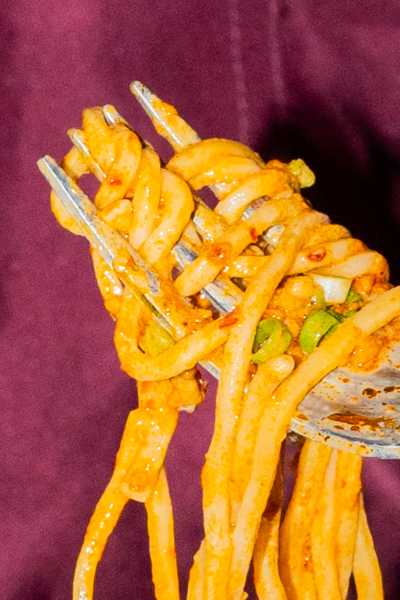
House-made noodles come with a variety of sauces and toppings. A vegan option is made with an egg substitute.
Honestly, it’s not that hard of a sell. As at Americans’ favorite quasi-upscale chain, the Cheesecake Factory, Din Tai Fung’s success hinges on utterly reliable, totally consistent quality. On each of my two recent visits, the food was exactly the same; each time, it was unimpeachably excellent. A beef noodle soup was warming and rich; a dish of Taiwanese-style cabbage, sautéed with incredible amounts of garlic, was bright and crisp-tender. Chilled cucumber salad, a signature, is plated with thick slices stacked in a ziggurat; it arrives dripping with chile oil so bright it verges on safety orange. The fried rice is just fine, but the fried pork chop you can get on top is phenomenal—boneless, juicy, duskily aflame with black and white ground pepper. But we’re here for the xiao long bao, which come in four varieties, to suit a range of gastronomic moods. The pork dumplings, the most traditional and seemingly the most popular, are served as a brace of ten in a steamer basket. On my visits, the meat—which comes from Kurobuta pigs, the Japanese name for the heritage Berkshire breed—was nicely seasoned and the broth both expectedly sticky and surprisingly bright; encased in thin, nearly translucent wrappers, the dumplings were lighter and more lively than nearly any I’d had before. A pork-and-crab iteration was heavy on the crab, with an appealingly intense minerality. For the high rollers, there’s a deluxe pork-and-truffle option, at twenty-eight dollars for a mere five dumplings but worthy of the price, with huge slices of black truffle slipped inside the wrapper with the meat, making the whole package earthy and wild. My favorite, perhaps controversially, was the chicken variety, whose meat was tender and whose broth was sweet with carrot and sharp with ginger, a golden panacea. (For vegetarians, there are vegan dumplings and wontons of the brothless variety, and they’re quite good, but against the dizzying excitement of the soup dumplings they do land a little bit like an afterthought.)
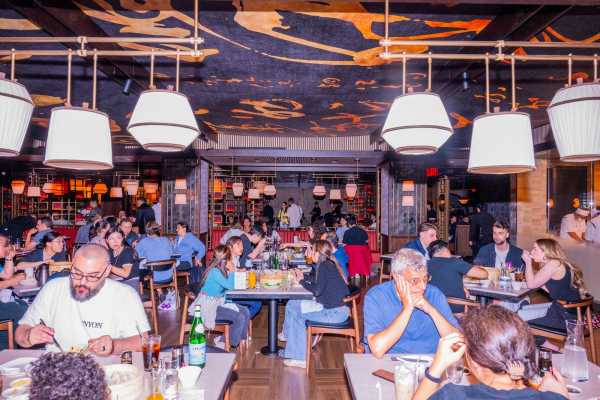
The New York location of Din Tai Fung, the chain’s largest yet, can accommodate four hundred and fifty souls.
From the moment you’re greeted, by a tablet-wielding host in the glass-box entrance, the entire Din Tai Fung adventure is choreographed with the friendly inflexibility of a mass-entertainment experience. The restaurant is a machine, though not an unpleasant one. You check in with one of the half-dozen people manning a long counter reminiscent of a hotel reception desk. They’ll direct you to one of two spacious lounges (one with curve-edged wooden benches, the other with plush upholstered banquettes), from whence you’ll be gathered and brought through the ocean of tables to your appointed place. In classic dim-sum style, you order by marking up a paper version of the menu with tick marks next to dishes you’d like; a server reads your order back aloud, just to be sure. There’s plenty of hand-holding for beginners—cards positioned on each table offer illustrated guides for mixing your own dipping sauces (the restaurant recommends a three-to-one ratio of black vinegar to soy) and for eating a soup dumpling (dip; place on spoon; puncture; devour)—but the food is serious stuff, no cut corners, no dumbing down.
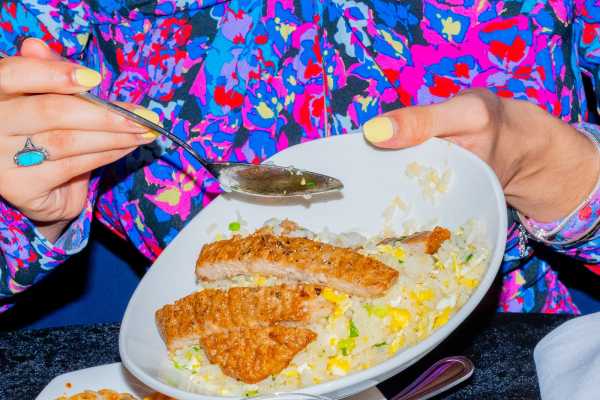
The fried rice is just fine, but the fried pork chop you can get on top is phenomenal.
Helen, Help Me!
E-mail your questions about dining, eating, and anything food-related, and Helen may respond in a future newsletter.
Dishes start to arrive moments after they’re ordered, emerging from a kitchen that’s visible behind glass walls in the back of the hangar-size dining room. Runners zip and zag among the tables, bearing teetering stacks of bamboo steamer trays, shedding the vertical layers table by table. Servers swing by to ask if you’re interested in some boba tea (they make it in-house), or a cocktail (see that enormous U-shaped bar all the way over there?), or another round of cucumbers, or maybe some dessert—dumplings, naturally, filled not unappealingly with chocolate ganache, or smooth, warm, sweet black-sesame paste. Time flows quickly, and also slowly; the walls are black, and far away; there are no windows. The transparent walls of the kitchen echo the uncanny fishbowl effect of the street-level entrance far above. The grid of tables and their identical accent lamps recede into the distance with mathematical regularity, the lighting somehow both overdim and overbright. More than once, I was struck with the disorienting feeling that I was hovering at the edge of the void. You could be deep below the streets of midtown Manhattan, or you could be on the ninth floor of a casino in Vegas, or you could be on a space station, or in Taipei, or in a shockingly real-feeling, slightly uncanny, notably delicious dream. ♦
Sourse: newyorker.com